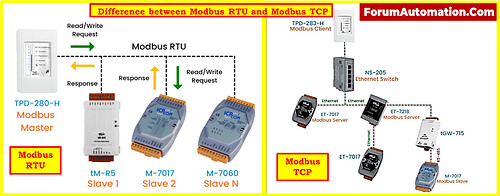- The two primary variations of the communication protocol Modbus, which is widely used in industrial automation and control systems, are Modbus RTU (Remote Terminal Unit) and Modbus TCP (Transmission Control Protocol).
- Although the fundamentals of the Modbus protocol are the same for both variations, they differ in terms of their underlying communication strategies, physical layers, and applications.
- Here, we examine the key distinctions between Modbus TCP and Modbus RTU.
Communication Medium:
Modbus RTU:
- For data transmission, Modbus RTU uses a binary encoding scheme and is intended to work across serial communication channels like RS-232 or RS-485.
- It uses a master-slave architecture where the master device sends requests to the slave devices to start communication.
- In the case of RS-232 or RS-485, the data packets are sent as a series of voltage levels or electrical signals.
Modbus TCP
- Conversely, Modbus TCP uses Ethernet networks as its communication channel.
- It makes use of the Ethernet network infrastructure by encapsulating Modbus messages into regular TCP/IP packets.
- The ability to communicate over LANs, WANs, and even the Internet is made possible through this.
Packet Structure:
Modbus RTU
- The data packets in Modbus RTU are made up of binary data that is represented by voltage levels or electrical signals.
- A unique slave address, function code, data, and a checksum for error detection are normally included in each packet.
- The packets’ binary structure makes them effective for serial connections and low-bandwidth communication.
Modbus TCP
- Because Modbus TCP messages are contained within TCP/IP packets, they follow by the standards of the Internet Protocol family.
- IP addresses, port numbers, and the Modbus payload are all included in each message. Compared to Modbus RTU, this structure enables advanced error checking and handling.
Speed and Data Transfer Rates:
Modbus RTU
- Modbus RTU is effective in transmitting data because it uses binary encoding, making it a good choice for applications where speed is not a top priority.
- However, compared to more recent protocols like Modbus TCP, its data transfer speeds may be somewhat slower.
Modbus TCP
- Ethernet networks, which are used by Modbus TCP, typically offer faster data transfer rates than serial connections.
- Because of this, Modbus TCP is appropriate for applications that need real-time data exchange and speedier communication.
Addressing
Modbus RTU
- Each device (slave) on the network in Modbus RTU is given a distinct numerical address ranging from 1 to 247.
- The number of devices that can be connected to the network is constrained by this addressing method.
Modbus TCP
- IP addresses and port numbers are used in Modbus TCP for addressing.
- This makes it possible for more devices to be linked to the network and makes it easier for users to communicate across LANs and WANs.
Advantages and Applications:
Modbus RTU
- Modbus RTU is simple to use and appropriate for applications where data transfer speed is not a top priority.
- common option for older systems is serial communication since it is well-suited for systems having a serial communication architecture.
Modbus TCP
- Modbus TCP is compatible with Ethernet networks and offers faster data transmission rates and more flexibility for real-time communication.
- It enables integration across geographically dispersed locations, making it appropriate for remote monitoring and control applications.
